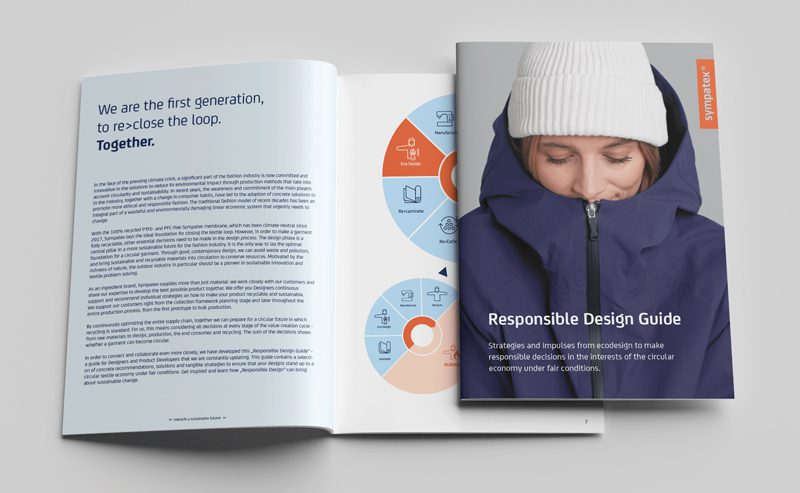Responsible Design Guide by Sympatex
- minutes reading time
Now, it's time for action. Whether you're a designer, brand owner, consumer, or industry stakeholder, you have a role to play in driving positive change.

1. What’s Sympatex’s Responsible Design Guide?
At its core, the Responsible Design Guide embodies Sympatex’s commitment to environmental stewardship and ethical practices. It serves as a blueprint for designers, providing practical strategies and actionable insights to integrate sustainability into every stage of the garment lifecycle. From material and trim selection to production processes, from supply chain management to end-of-life solutions, the guide offers a holistic approach that empowers brands to make informed choices for a better future.
Get inspired and learn how „Responsible Design“ can bring about sustainable change.

2. Why do we share our knowledge?
At Sympatex we believe in collaboration and open source!
Join forces with like-minded individuals and organizations to amplify your impact. By collaborating on initiatives and sharing best practices, we can accelerate progress towards a more sustainable and ethical fashion industry. Therefore, we share our Responsible Design Guide with everyone.

3. What’s Design Thinking
„Design thinking“ is a methodology that aims to solve problems and develop new, innovative ideas. The aim is to find solutions that are both convincing from the user‘s point of view and at the same time are market- and product-oriented. This approach is ideal for designing recyclable products and can produce extraordinary solutions.
In the Responsible Design Guide, we show you some ideas from the methodology. If required, we will be happy to offer your team comprehensive workshops.
4. What’s Ecodesign?
By definition, „sustainability“ comprises three aspects: Economic, environmental and social sustainability. There are many creative ways to find solutions for the fashion industry in relation to various requirements. With the help of the „Responsible Design Guide“, we would like to show you some suggestions, strategies and solution approaches to explore together what responsible design in functional clothing can look like from various aspects of sustainability and how this „limitation“ can also serve as a driver for creativity and innovation.

5. What’s Design2Recycle?
The way fashion is consumed and produced today is primarily a one-way street. Significant changes are needed in the fashion industry to avoid waste and regenerate nature. Our goal is to minimize the environmental impact as much as possible. An important part of the solution is the circular economy.
Circular fashion requires thoughtful, conceptual and responsible design from the outset and is based on better choices that are essential to build a sustainable brand in the future. Combining the solutions of Ecodesign with the recycling concepts of Circular Design together with fair conditions, this will have the intense impact of Responsible Design and bring about powerful change.
If you as a designer positively change the way you develop products and consider the circular economy when designing, you can play your part in creating a more sustainable fashion industry with great impact. Design2Recycle is an opportunity to take action as a designer and develop more circular products with a lower environmental impact.

6. Why you better read it now:
The „ESPR“ proposal for new ecodesign guidelines is the centerpiece of the EU‘s „Green Deal“ and is described as groundbreaking for the textile sector. The proposal creates a framework for setting ecodesign requirements for specific product groups, including textiles, to improve their circularity. Similarly, the Digital Product Passport will play a key role by increasing transparency and unlocking the potential of the circular economy.

In our „Responsible Design Guide“, we would like to give you an overview of the scope and the requirements for you as a brand, because in the future, these legislative initiatives will trigger major changes in the apparel sector.
Learn how you can design your products to be circular, energy efficient and fair. In order to gain a better understanding of the specific requirements that will change the textile and clothing sector in the coming years, the most important points of the proposed legislation were summarised as follows:
- product durability, reusability, upgradability and reparability
- presence of substances that inhibit circularity
- energy and resource efficiency
- recycled content
- remanufacturing and recycling
- carbon and environmental footprints
- information requirements, including a Digital Product Passport

As we embark on this collective endeavor, let us embrace the principles of sustainability, innovation, and responsibility, ensuring that outdoor gear remains a force for good in the world.
We are proud and grateful to work with innovative partners beyond the outdoor industry along the entire value chain to advance the vision of the circular economy and sustainability. We can only do this effectively if we work together towards a circular future for fashion.
Are you interested in using our climate-neutral and recyclable Sympatex membrane? We would be happy to show you our material samples to lay the foundation for your circular garment:
Apparel: Anja.Palic@sympatex.com & Jessica.Dedora@symatex.com
Workwear: Petra.Klattenhoff@sympatex.com
Footwear: Yasemin.Malcolm@sympatex.com
Consulting in the field of Eco- & Circular Design: Lisa.Polk@sympatex.com
Information on recycling strategies: Martin.Mayershofer@sympatex.com